ASUS G73Jw: Out with the Old, In with the New
by Jarred Walton on November 3, 2010 12:33 AM ESTASUS G73Jw: Battery Life, Noise, Heat, and the LCD
So we’ve got the same chassis, a CPU that’s the same power spec, but a different GPU. We mentioned in the past that it appears AMD could do more to tweak the 5800 mobile parts for better battery life. Without the ability to retest notebooks months later (i.e. with the latest driver updates), all we have to go on are previous results. Battery life ends up being the one area where the G73Jw is clearly superior to the G73Jh.
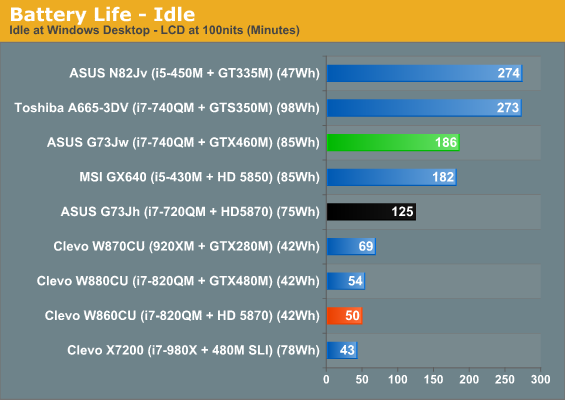
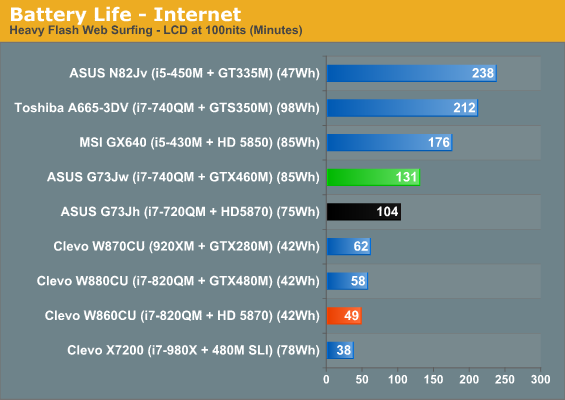
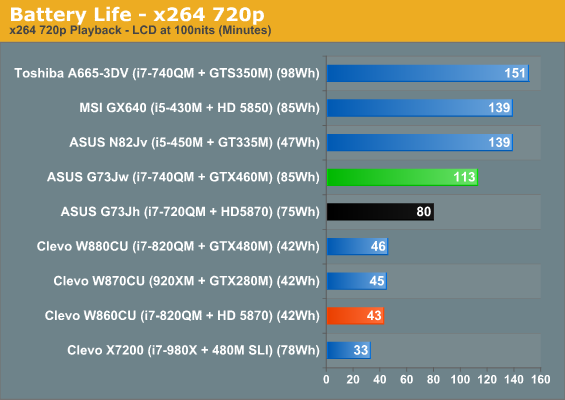
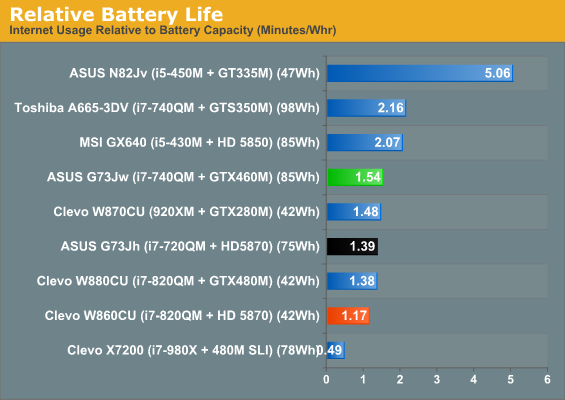
Idle battery life improves by 49%, Internet battery life is up 26%, and x264 playback is up 41%. HWMonitor even reports a wear level of 5-6% on the battery, despite over ten charge/discharge cycles, so potentially you could see even better results. However you slice it, the GTX 460M looks to be far better at idle power use than the 5870—for that matter, even the GTX 480M competes well with the HD 5870. Obviously you’re not going to buy any of the gaming notebooks as an all-day mobile solution, but it’s nice to at least get two to three hours if you need it.
If you’re interested in gaming on the battery, we also need to offer a word of caution. While we still got an hour of battery life looping 3DMark06, performance was one-third to one-fourth the speed we measured on AC power. In other words, unplug the G73Jw and the 460M suddenly starts performing like a GT 320M. That’s with the system using the highest performance options in the power settings we could select. Whether the low performance is necessary because of lack of available power from the battery, or if it’s simply a case of NVIDIA/ASUS hindering performance in order to improve battery life, unplugged the G73Jw is not going to be a gaming powerhouse.
Again we have HWmonitor reporting up to 54W of power use by a Clarksfield CPU, which is the TDP of the Extreme versions rather than the standard models. Minimum power draw for the 740QM is a massive 14W—more than some laptops use for everything at idle. Maximum CPU and GPU temperatures are very good, again highlighting how effective the G73 design is. We’re still curious as to why it’s only a 460M in the chassis, as it appears capable of handling more. Then again, perhaps it’s the power constraints rather than cooling that prevents ASUS from using something faster—and ultimately, even the mighty 480M only looks to be about 15% faster than the 460M. All things considered, the 460M looks like a good choice for the G73Jw; we’re just not convinced it’s dramatically superior to the HD 5870 in the previous model, outside of better idle power use.
The LCD: Nothing New Here
We’re not going to show detailed results for the LCD, since we’ve already seen this particular panel in the original G73Jh as well as the Clevo W880CU and X7200. It’s a good panel with an extremely high contrast ratio—we measured more than 1100:1! The down side is that maximum brightness is under 200nits, and in fact the G73Jw only manages 163nits. With such a low maximum white level, we had to double check to verify that the panel is even using LED backlighting, but it is; it’s just not particularly bright backlighting. Color accuracy and gamut are also good if not the absolute best we’ve seen. If you want to read more about the HannStar HSD173PUW1, you can refer to our G73Jh review or the X7200 review. We like the panel, but we’d still love to see a better color gamut and at least 300nits maximum brightness.


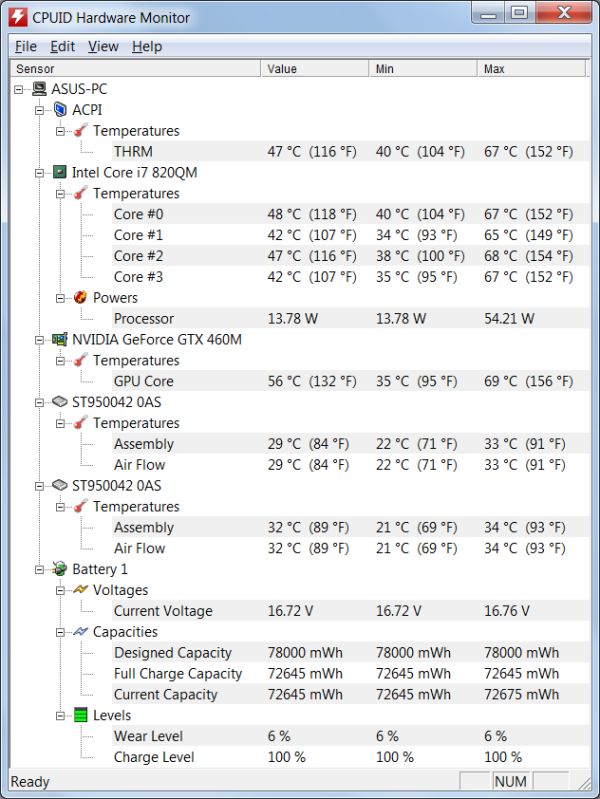








53 Comments
View All Comments
JarredWalton - Wednesday, November 3, 2010 - link
Sorry, you're correct. It's 60GB/s bandwidth and a 192-bit interface, which means the GDDR5 is running at 625MHz and not 1250, or an effective speed of 2.5GHz. I've updated the table.radium69 - Wednesday, November 3, 2010 - link
Hey anand,I just bought a MSI GX740 and suggest you review this model aswell!
The build quality is sturdy and the frame is put together nicely.
Specs:
MSI GX740
Intel Core i5 460M
2x 2GB DDR 1066
500GB 7200RPM HDD
ATi Radeon 5870M
Comes with a carrying bag and mouse aswell.
Cost: 1100 euro
(This is a Dutch version, your versions in the US are cheaper and better equipped!)
You might want to give it a look, I'm sure you won't be dissapointed.
Also the battery life is great with it's 9 cell battery (83Wh)
The asus costs well over 1600 Euro here, so if you compare them the MSI is really budget friendly, without breaking the bank, and sacraficing performance!
Regards,
Kevin
JarredWalton - Wednesday, November 3, 2010 - link
How's the keyboard feel? I tested the GX640 a while back, and everything was fine other than the horrible keyboard. I would be surprised if the GX740 is much better, but it does have an HD 5870 in there IIRC, and the price is definitely attractive.radium69 - Wednesday, November 3, 2010 - link
The keyboard feels well made! I'm typing from it right now, it might not be as good as the Asus. But I think it is really easy to get used to.My desktop PC has a G15 though, and allthough the G15 gives more feedback, I think this MSI keyboard is pretty solid. You should definitely give it a try.
The only little minus is that the function key is on the CTRL spot. But getting used to that is fairly easy.
I think it is also light and very portable for a 17"
Hope to see it in future benchmarks!
I bought the i5 for its lower TDP and better battery life.
It can certainly hold it's ground compared to other laptops.
I can tell that the GX660 (new one 15") Is really gimmicky looking. But the GX740 feels more smooth and has a professional look and feel to it.
MSI even ships a mouse and carrying bag with it. So that saves you another 50 dollars or so.
Hope to see it soon on here!
There is a lot of good stuff on it and it works flawlessy so far.
Definitely a laptop to review!
Regards,
Kevin
Aikouka - Wednesday, November 3, 2010 - link
I'm looking at the laptop on NewEgg and one thing that may make for an odd review is..."Resolution 1680 x 1050"
You'd probably only be able to test it at 1600x900 then since I don't think you guys even benchmark at 1680x1050 anymore... especially since a lot of laptops aren't even 16x10 anymore! :P Unfortunately, only showing 1600x900 wouldn't do much for people looking for performance at its actual settings, but I guess there could just be a table with the 1680x1050 results if there are no other laptops to compare it to at that resolution.
JarredWalton - Wednesday, November 3, 2010 - link
We test at 1600x900 because it's becoming more common than 1680x1050, but we'd also throw in the native resolution benchmarks (and we'd hook up to an external LCD for 1080p tests as well). I guess all we really need is for MSI to send us a GX740. :-)Aikouka - Wednesday, November 3, 2010 - link
Ahh good call on the external monitor. I guess I wasn't thinking outside the box... or should I say "case"? ;)I certainly find no fault in not testing at 1680x1050 anymore as it isn't very common now that a lot of monitors (external or built into laptops) are running at a 16x9 resolution.
The MSI laptop did look pretty decent spec-wise though, but the one thing I've always liked about the ASUS is the fact that it has two HDD bays. I don't recall the MSI laptop having that.
The laptops that have actually disappointed me the most lately have been the newer Dell XPS models... they just seem to still not be centered around... well... good choices. I bought one of the older Dell XPS M1530s back in the day and I still really like the laptop (even with the slow GeForce M8800GT). What disappoints me, is that the 17" XPS, even with the fastest graphics card offering available, does not have a 1080p display option, or at least did not when I tried to configure one. The 15" actually had the 1080p option available, but does not have the fastest GPU as an option... bummer.
StrangerGuy - Wednesday, November 3, 2010 - link
A gaming laptop that already struggles with today's games at its native resolution? I don't even want to imagine how it's going to run future DX11 games.whatthehey - Wednesday, November 3, 2010 - link
It's all relative. HP and Dell sell "gaming" desktops with 5470 and GT 220 cards, which would be slower than the G73. If your goal is to get a gaming laptop that can max out every game, you better have a lot of money for something like the X7200 or else reset your expectations. Traditionally, gaming laptops have never been capable of maxing out game settings on the latest titles, especially when even desktops need two higher clocked GPUs to manage that. If you look at other gaming laptops (i.e. Clevo models with either HD 5870 or GTX 480M) and how much they cost, the G73Jh/Jw is still an awesome bargain, and it's not quite the eyesore of Clevo notebooks! That's my take anyway.Sufo - Wednesday, November 3, 2010 - link
Heh, it's all good - apart from the odd title scattered here and there in 2011, you won't be seeing many of those "future DX11 games" till 2012. PC gaming has plateaued until the next round of consoles.